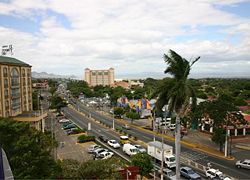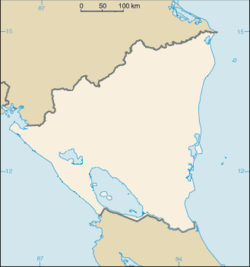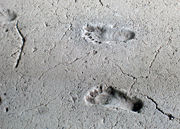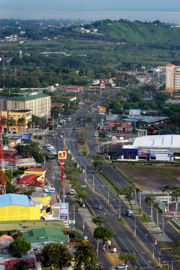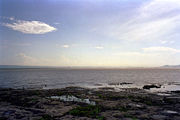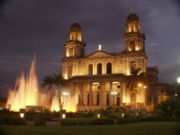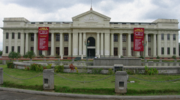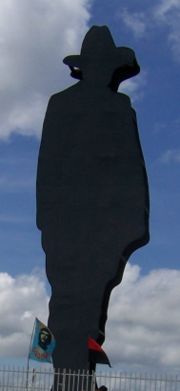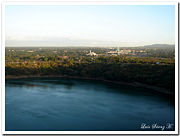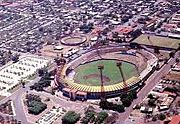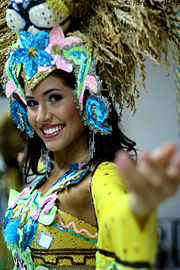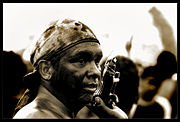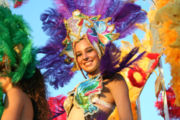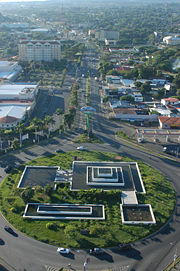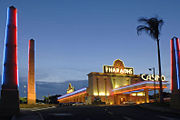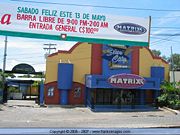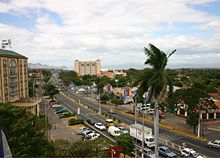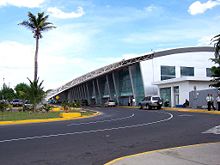Managua
2008/9 Schools Wikipedia Selection. Related subjects: Central and South America; Cities
| Managua | |||
|
|||
| Nickname(s): La Novia del Xolotlán (English:The Bride of Xolotlán) |
|||
| Map of Nicaragua showing location of Managua. | |||
| Coordinates: | |||
|---|---|---|---|
| Country | |||
| Department | Managua | ||
| Municipality | Managua | ||
| Founded | 1819 | ||
| Seat of the Government | 1852 | ||
| Capital of the Nation | 1852 | ||
| Government | |||
| - Mayor | Dionisio Marenco | ||
| - Vice Mayor | Felipe Leiva | ||
| Area | |||
| - City | 544 km² (210 sq mi) | ||
| - Urban | 173.7 km² (67.1 sq mi) | ||
| Population | |||
| - City | 1,680,100 | ||
| - Density | 2,537/km² (6,570.8/sq mi) | ||
| Website: http://www.managua.gob.ni/ | |||
Managua is the capital city of Nicaragua as well as the department and municipality by the same name. It is also the largest city in Nicaragua. It is located on the southwestern shore of Lake Managua. The city was declared the national capital in 1852. Previously, the capital had alternated between the cities of León and Granada. The city has a population of about 1,680,100; composed predominantly of Spanish-speaking criollos (unmixed Europeans), whites and mestizos.
Founded in 1819 and given the name of Leal Villa de Santiago de Managua, its original purpose was to serve as a rural fishing village. Efforts to make Managua the capital of Nicaragua began in 1824, after the Central American nations became independent from Spain. Managua's location between the rival cities of León and Granada made it an ideal compromise site.
The city has been witness to the rise and fall of political powers throughout Nicaragua's history, and has suffered two devastating earthquakes over the course of the 20th century. Managua is the economic, political, cultural, commercial and industrial centre of Nicaragua.
In 2007, after a successful literacy campaign, Managua was declared the first capital city in Central America to be rid of illiteracy.
Etymology
The name Managua originates from Mana-ahuac, which in the indigenous Nahuatl language translates to "adjacent to the water" or site "surrounded by water". The city stands today on an area historically inhabited by Indigenous people centuries before the Spanish conquest of Central America in the 16th century.
History
Nicaragua was inhabited by Paleo-Indians as far back as 6,000 years ago. This is confirmed by the ancient footprints of Acahualinca found along the shores of Lake Managua, along with other archaeological evidence, mainly in the form of ceramics and statues made of volcanic stone like the ones found on the island of Zapatera and petroglyphs found in Ometepe island.
It was not until 1857, after Granada was destroyed by a U.S. mercenary army led by William Walker, that the capital was firmly established in Managua. Between 1852 and 1930 Managua underwent extensive urbanization; becoming a base of governance, infrastructure and services. The city was hampered by major floods in 1876 and 1885 and a disastrous earthquake in 1931, which destroyed much of the city. Under the rule of dictator Anastasio Somoza García and his family (1936–1979), it began to grow rapidly. New government buildings were erected, industry developed, and universities were established; Managua had become Central America's most developed city. Yet, the city suffered a second major earthquake on December 23, 1972, which destroyed 90% of the city and killed over 10,000 people. The city was cleared, however it never returned to its previous state. The earthquake caused many of Managua's residents to find refuge in the outskirts of the city. The old downtown has not been rebuilt to this day for fear of future earthquakes.
Geography
Managua is located on the southern shores of Lake Managua (also known as Lake Xolotlán). Lake Xolotlán contains the same fish species as Lake Cocibolca, except for the freshwater sharks found exclusively in the latter. Once a Managuan scenic highlight, the lake has been polluted from the dumping of chemical and waste water since 1927. A waste water treatment plant funded by the German government to decontaminate the lake is expected to be the largest in Central America and will be completed in 2008.
Managua extends about 544 km along Lake Managua at an altitude of 55 metres (165 ft) above sea level, gaining altitude towards the sierras de Managua where it is over 970 metres (2910 ft) above sea level.
Lagoons within city limits
Managua features four smaller lagoons within the city limits. The most centrally located is the Tiscapa Lagoon located in the Tiscapa Lagoon Natural Reserve. The Laguna de Tiscapa (Tiscapa Lagoon), south of the old downtown. Tiscapa Lagoon is of volcanic origin and was formed approximately 10,000 years ago. Asososca lagoon, to the west, is Managua's most important source of drinking water. Asososca is located at the beginning of Carretera al Sur (Southern Highway), close to the connection with the Carretera Nueva a León (New Highway Via León). Nejapa lagoon, south of the Asososca lagoon, is also along the Southern Highway. The fourth lagoon is Acahualinca lagoon, which is located to the Northwest. This lagoon, which gives its name to a nearby district to the east, is located on the shores of Lake Managua. This lagoon is mostly noted for having shallow waters.
Climate
Managua, like much of Western Nicaragua except for the Sierras, has a tropical climate with constant temperatures averaging between 28 and 32 degrees Celsius (82 and 90 degrees Fahrenheit). The months of December and January are chilly, whereas March and April are humid and somewhat arid.
Flora
Managua, due to its tropical climate, varied topography, naturally fertile soils, and abundant rain and water sources, boasts a great variety of flora. Therefore, many different types of trees (some of them not found in the rest of the world, such as chilamates, ceibos, pochotes, genizaros, tiguilotes, royal palms, pinuelas and the madroño, which is Nicaragua's national tree) surround the city. During the rainy season (May to November), Managua becomes a lavish city due to many palms, bushes, and other plants and trees which dominate much of the city’s image.
Education
Managua is the national education centre, with most of universities and higher education institutions based there. Nicaragua's higher education consists of 48 universities and 113 colleges and technical institutes which serve student in the areas of electronics, computer systems and sciences, agroforestry, construction and trade-related services. The educational system includes 1 U.S. accredited English-language university, 3 Bilingual university programs, 5 Bilingual secondary schools and dozens of English Language Institutes. In 2005, almost 400,000 (7%) of Nicaraguans held a university degree. 18% of Nicaragua's total budget is invested in primary, secondary and higher education. University level institutions account for 6% of 18%.
Colleges and universities
- National Autonomous University of Nicaragua
Universidad Nacional Autónoma de Nicaragua (UNAN) (National Autonomous University of Nicaragua) is the principal state-funded public university of Nicaragua. UNAN was established in 1812 and its main campus is located in Managua. The original campus, UNAN-Leon, is located in León and is now secondary, mainly used for medicine majors.
- Polytechnic University of Nicaragua
Universidad Politecnica de Nicaragua (UPOLI) (Polytechnic University of Nicaragua) is a university located in Managua, Nicaragua. It was founded in 1967. The university is divided into 6 schools: School of Administration, Commerce and Finance, School of Law, School of Design, School of Nursing, School of Engineering, Music Conservatory.
- Instituto Centroamericano de Administracion de Empresas
Instituto Centroamericano de Administracion de Empresas (INCAE) (Central American Institute of Business Administration) is a private business school. INCAE was founded in 1964 with the support of the United States government and other Central American countries . The institution has a close affiliation with Harvard University, as it had played a part in its foundation. The Francisco de Sola campus in Managua, Nicaragua was the first to be established (1964), the Walter Kissling Gam campus in Alajuela, Costa Rica was the second established in 1984.
According to a study done by America Economia INCAE ranked as the number one business school in Latin America for 2 consecutive years (2004, 2005) and ranked in the top ten international business schools by The Wall Street Journal in 2006.
- Other universities
|
|
|
Economy
Managua is the economic centre and a generator of services for the majority of the nation. Unlike many other Latin American countries, it does not suffer from massive migration of country peasants looking for work in the city, since many other cities of Nicaragua have well established economic industries. Nonetheless, as it is the only city with a population exceeding one million inhabitants, it houses many large national and international businesses. It is home to many factories which produce diverse products. Multinational companies such as Wal-Mart, Telefonica, Union Fenosa, and Parmalat have offices and operations in Managua.
Managua is also home to all of the major banks of the nation, Banco de la Produccion (BANPRO), Banco de America Central (BAC), Banco Uno, Banco de Finanzas (BDF), Banco de Crédito Centroamericano (BANCENTRO) and its parent company the LAFISE Group. Several new hotels including Crowne Plaza, Best Western, InterContinental, Holiday Inn, and Hilton currently have facilities in Managua. As well as many hotels, Managua has opened four western style shopping centers or malls, such as Plaza Inter, Centro Comercial Metrocentro, Galerias Santo Domingo , and Multicentro Las Americas with many more being constructed.
There is a huge established local market system that caters to the majority of the Nicaraguan population. The Mercado Roberto Huembes, Mercado Oriental, Mercado Israel Lewites and other locations are where one can find anything from household amenities, food, clothing and electrical and other contracting supplies. Many of the backpacking, ecotourism types and tourists on a budget use these markets for their supplies. Although one needs to use caution regarding wallets and personal items (as with many public markets around the world) the markets can be the source of high quality and unique items. Tourists looking for an authentic experience should consider these destinations as there is always something interesting to eat and local customs to be experienced.
Managua is also currently experiencing an upsurge in real estate prices and as well as a housing shortage. Foreigners, mainly from North America and Europe, are becoming interested in considering post- retirement life in Nicaragua. The capital is also a need for modern office space in downtown Managua as the economy of Managua continues to grow. Economists predict that its demand for commercial real estate will increase. New office buildings are currently being constructed along the Carretera Masaya and in Villa Fontana. The most recent inauguration being the Edificio Invercasa.
Sites of interest
Plaza de la Revolución
Plaza de la Revolución (Plaza of the Revolution), which was formerly known as Plaza de la República (Plaza of the Republic) is home to Managua's Historical Center. Managua's Center was destroyed by the 1972 earthquake. Managua, to date, has not rebuilt its center. The now Historical Centre is located near the Lago de Managua and many building are partially intact, however, some are now abandoned. Some of the more important buildings which managed to survive include the Catedral de Santiago (Old Cathedral), the Rubén Dario National Theatre, and the National Palace of Culture. Within the Plaza of the Revolution is the Parque Central (Central Park) which contains many historical monuments, many dedicated to inspirational people, national heroes and poets. Some of these include the Tomb of Comandante Carlos Fonseca, founder of the FSLN, which is guarded by an eternal flame. Near Central Park is the Rubén Darío park, dedicated to Nicaragua's national poet. There is also a park dedicated to the Guatemalan writer Miguel Ángel Asturias. Monuments include the monument of El Guerrillero sin Nombre (The Nameless Guerrilla Soldier) and Monumento a la Paz (Monument for Peace).
Old Cathedral of Managua
The old Cathedral of Managua was designed in, and shipped from Belgium in 1920. The cathedral survived the 1931 earthquake but was extremely damaged due to the 1972 earthquake and was condemned, which led to the construction of the new cathedral of Managua, the newest constructed Roman Catholic cathedral. However, in recent years, the restoration of the old cathedral has appeared to be possible and is currently awaiting its renovation.
Rubén Dario National Theatre
The Rubén Dario National Theatre is Nicaragua's most important theatre, and is one of the most modern theaters in Central America. Both national and international artists present shows, concerts, exhibitions, and cultural performances such as El Güegüense among many others. The National Theatre is one of the few buildings that survived the 1972 earthquake that destroyed 90% of Managua.
National Palace of Culture
The National Palace is one of the most impressive buildings in Nicaragua. It was built by President Juan Bautista Sacasa in 1935 and it houses plenty of history. For more than 50 years, the National Palace was used as governmental office and now serves several purposes. The National Palace houses the National Archive, the National Library, as well as the National Museum which is open to the public. The museum features paintings, pre-Columbian statues, ceramics, etc. Also present inside is the National History room, as well as a room with the National Symbols. The National Palace of Culture (Palacio Nacional de la Cultura) was one of few building that survived the 1972 earthquake.
Tiscapa Lagoon (Natural Reserve)
The Tiscapa Lagoon, located inside the Tiscapa Lagoon Natural Reserve is just south of the Managua's Historical Centre. Leading up to the Lagoon is the Monumento Roosevelt (Roosevelt Monument). Another interesting monument is the statue of Sandino which is a statue of the Silhouette of General Augusto C. Sandino, Nicaragua's national hero and stands at 59 feet tall. The monument was proposed by Ernesto Cardenal and is protected by the Nicaraguan military. The Sandino monument was constructed on top of the wreckage of Somoza's presidential mansion. Also on the crater lip of Tiscapa is the Las Masmorras, a prison in which Somoza tortured current President Daniel Ortega and many other political prisoners, however, this site is closed to the public.
The reserve is located within city limits of the capital, Managua, and is a popular tourist attraction. Restaurants and stores line the walls of the lagoon. Canopy rides provide a panoramic view of the old downtown where only a few buildings survived the 1972 earthquake that destroyed 90% of the capital city, however, many new buildings and shopping malls have been built since then throughout the city due to the lack of a new centre. Many pre-Columbian artifacts have been found in and around lagoon and reserve.
Dr. Roberto Incer Barquero Library
The Dr. Roberto Incer Barquero Library, located in Managua, is designated to promote Nicaraguan culture. The library has 67,000 books, free internet, a newspaper archive where users can borrow newspapers and magazines, and economical information of the Central Bank. Furthermore, the library offers a gallery in the same building, where famous Nicaraguan paintings, as well as pieces from new promising artists, are exhibited. In the numismatic hall there is a permanent exhibition of Nicaraguan coins, bills, and memorial medals from throughout Nicaragua's history.
Museum of Acahualinca
Managua is also home to the Museum of Acahualinca where the Ancient footprints of Acahualinca, fossilized Paleo-Indian footprints made some 6,000 years ago, are engraved in volcanic ash. The museum "Museo Sitio Huellas de Acahualinca" is located in west Managua in the Acahualinca neighbourhood. In addition to the footprints, the museum also displays artifacts found in other localities around the country. Artifacts such as mammoth footprints, pre-Columbian tools, a skull from León Viejo, and a small collection of pottery among other archaeological objects.
Dennis Martínez National Stadium
The Dennis Martínez National Stadium was built in 1948 and was the largest stadium in Central America at the end of its construction, it survived the 1972 earthquake. The stadium was named in honour of Nicaragua first baseball player to play in Major League Baseball, it serves as a venue for baseball and football (soccer) games, as well as concerts and religious events. The Dennis Martínez National Stadium has a capacity for 40,000 making it the largest stadium in Nicaragua.
The New Cathedral
The Catedral Metropolitana de la Purisima Concepcion ( Metropolitan Cathedral of the Immaculate Conception), more commonly referred to as La Nueva Catedral (The New Cathedral), was designed by the architect Ricardo Legorreta and inaugurated in 1993. The new cathedral was built to replace the old cathedral, which had been damaged by the 1972 earthquake. The new cathedral has created much controversy, particularly about its architectural style and finance.
Culture
Managua is Nicaragua's cultural capital, boasting several restaurants, theaters, museums, and luxurious shopping centers. The city is also home to many communities of immigrants and ex-pats from but not limited to: Taiwan, China, Germany, the United States, Palestine, and Latin American countries.
Managua is home to the annual Miss Nicaragua pageant; it is the national beauty pageant of Nicaragua. The pageant is traditionally held at the Rubén Darío National Theatre and has been held since 1955. The Miss Nicaragua pageant is responsible for selecting the country's representatives to the Miss Universe, Miss World, and Miss International pageants (amongst others).
Gastronomy
Managua has an important gastronomical culture, due to the influence of immigrants and tourists, for that reason it is frequent to find food specialties of the diverse regions of Nicaragua, jointly with international ones. Managua enjoys an array of international cuisine, including, but not limited to, Argentine, Brazilian, Chinese, French, German, Indian, Italian, Japanese, Mexican, and Spanish restaurants, as well as Nicaraguan. These are accompanied by many U.S. fast food chains, as well as national fast food chains such as Tip-Top and Rosti-Pollo. A new culinary school and restaurant called Culinario Santa Lucia offers fun courses in international and local cuisines.
Festivals
Managua's most famous festival is that of its patron saint Santo Domingo de Guzmán. It starts on the morning of August the 1st, when the "Bajada del Santo" (walk down of the saint) involves many joyful people walking and carrying the old statue of Santo Domingo from Las Sierritas Church in south Managua, to another church across the city to the north, in the area destroyed by the 1972 earthquake. It remains here for ten days until the morning of August the 10th, when the "Subida del Santo" (walking up of the saint) returns the statue to Las Sierritas Church where it remains for the rest of the year. Thousands of people attend this event which involves dancing, eating and drinking around marching musical bands, mainly for traditions that date back to pre-colonial times, or to ask for personal miracles, make promises, or give thanks to the saint . During the parade many people dress up in typical costumes, masks and painted bodies. Among other participants are "carrosas" (art cars and trucks) from local business companies, horseriders coming from Nicaragua and other Central American neighbouring countries to show off their horses, skills, and horserider costumes.
Another and newer festival has been taking place every year since 2003. The "Alegria por la Vida" (Happiness for Life) Carnaval is celebrated in Managua at the beginning of the month of march. There's a different slogan or theme every year. This event is celebrated with parades, floats, live music, food and dancing as well as the march of the Carnival Queen.
Museums, libraries and cultural centers
The National library holds a great amount of volumes, and affords abundant bibliographic information for anyone interested in the discovery and independence of Nicaragua. The National Palace of Culture has on show an interesting exhibition of Nicaraguan art from the periods previous to its independence. Also located inside the National Palace of Culture is the National Museum containing some highly interesting archaeological finds with some good examples of pre-Columbian pottery, statues, and other interesting finds. Managua is also home to an array of art galleries which feature pieces by both national and international artists.
Managua is home to many types of museums, some art museums include the Julio Cortazar Museum and the Archivo Fílmico de la Cinemateca Nacional. Natural history museums include the Museo del Departamento de Malacología UCA, Museo Gemológico de la Concha y el Caracol, and Museo Paleontológico “El Hato”. The Santo Domingo de Guzmán Museum is an anthropology museum. History museums include the Museo de la Revolución, Museo Casa Hacienda San Jacinto, Museo Histórico Municipal de Coritno, and Museo Parque Loma de Tiscapa.
Cultural centers in Managua include the Centro Cultural Nicaragüense Norteamericano (CCNN) (Nicaraguan-North American Culture Centre), the Centro Cultural Chino Nicaragüense ( Chinese Nicaraguan Culture Centre), the Alliançe Française de Managua (French Alliance of Managua), among others.
Entertainment
Managua features many bars, nightclubs, casinos, theaters and cinemas. Compared to western prices, alcoholic beverages, theatre visits and cinema tickets are relatively cheap. There are cinemas in all major shopping centers; screening both English- and Spanish-language films. Foreign embassies in Managua also sponsor film festivals.
Since the late 1990s and early 2000, many casinos and karaoke bars opened and have remained popular attractions for Nicaraguans and foreign visitors. They are open to anyone above 21 years old. However there's been moral controversy about the negative effects of gambling in a country with so much poverty. Popular music includes the Palo de Mayo, Merengue, and Latin pop among other Latin music genres, as well as American pop and rock. Salsa dancing is a national pastime. Nightclubs and bars are abound in Managua, particularly, in the popular areas called "Zona Hippos" behind the Hilton hotel near Metrocentro and "Zona Rosa".
Aside from these activities, Managua also has a wide selection to offer in luxurious shopping malls, boutiques and department stores as well as local markets. The Mercado Roberto Huembes is where shoppers can find everything from furniture, national arts and crafts, to fruits and vegetables, and clothing. Also there are several shopping centers with department stores such as ECLIPSE, CARRION, and SIMAN which house all major Australian, American and European clothing and cosmetic brands for both men and women. Pali, La Union, and La Colonia are conventional supermarkets, which are located in several areas of the city, and sell local and imported ingredients from all over the world.
Although the act of promoting or practicing homosexuality is illegal in Nicaragua, there is a modest gay social scene in Managua. Also, as of March 2008, homosexuality will no longer be illegal or carry any prison sentence.
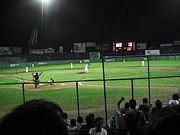
Sports
Baseball is by far, Nicaragua's most popular sport followed by football soccer and boxing. The Dennis Martínez National Stadium is home to many baseball games of Managua's Boer team. At the time of its construction in the late 1960s, it was the most modern stadium in Central America. It hosted the Baseball World Cup in 1994. Baseball was first introduced to Nicaragua in 1888 in the Caribbean coastal town of Bluefields, but didn't catch on in the towns on the Pacific coast region until 1891 when a group of mostly students originating from universities of the United States formed "La Sociedad de Recreo" (Society of Recreation) where they played various sports, however, baseball was the most popular among them.
Since the anticipation of the World Cup of 2006, there's been growing amateur interest in the practice of little football or "futbolin" among teens and adults. New private courts or "canchas" like La Meca del Futbol and La Liga, offer well conditioned courts for rent by the hour. Such establishments have played a big role in the promotion of amateur games and fun tournaments. On the professional level, the National Nicaraguan Football team has still not had the public support nor the international exposure as the regional counterparts from Central America like the Costa Rican or Honduran teams. However, with support of the FIFA, the first ever national football stadium in Managua is currently under construction. In Managua there are 2 golf courses, the better known of which is Nejapa Golf & Country Club.
Crime
Nicaragua has been rated the safest country in Central America by various sources. Statistics and surveys by INTERPOL, the United Nations, INCAE, the Inter-American Human Rights Institute and the Police Forces in the Americas show that statistically, Nicaragua has the lowest crime rate in Central America and one of the lowest in Latin America. In addition, Nicaragua has the lowest homicide rate in Central America. In 2007 the homicide rate was 14 per 100,000 people. Managua has also been rated the safest capital in the region, however, 40% of the crime that occurs in Nicaragua is centered in Managua. In 2005 Managua experienced a growth of 23.2% in crime, although it is the safest capital in the region, crime rates for Managua and neighboring cities have been rising over the past years. In Managua, the most common type of crime is property crime, petty theft and street crime such as robbery and mugging.
Neither Nicaragua or the city of Managua have major gang problems, in comparison to its regional neighbors. However, in Nicaragua, as in all other Central American countries, as well as in the U.S., the Salvadoran-founded MS 13 gang has recruited members. Despite their presence in the country, Nicaragua has the lowest number of MS 13 members in Central America. The number of gang members was estimated at 4,500 throughout the country, lower than all of its Northern neighbors in the region (excluding Belize). In 2003, the Policía Nacional de Nicaragua (National Police of Nicaragua) recognized gangs committed only 0.51% of all crimes. In 1991, there were 110 gangs in Managua, in 2001 the number of gangs reduced to 96 gangs with a total of 1,725 members. Over the next 3-4 years the number of gangs and gang members both decreased and increased. In late 2005 the number of gangs and members decreased significantly to 34 gangs and their 706 members in Managua, these represented 38% and 32% of the national total of gangs and its members. In a recent report by La Prensa, Chief of Police, Aminta Granera, stated that vehicles robberies has reduced; a mere 200 reports were filed in 2006.
Urban planning
The German government is currently funding the construction of a water treatment plant with plans to process the city's sewage and clean the Managua lake. When finished, it will be the largest water treatment plant in Central America. Also pending is a mega-project to reconstruct the old centre of Managua, and to introduce a monorail system, to alleviate future transportation problems in Managua. Both of these projects will revitalize the old centre of Managua and boost tourism, commerce, infrastructure and economic development.
Hospitals
The best hospitals in Managua are private since they have newer facilities, equipment, and access to international insurance companies. Emergency services are faster than the public hospitals and the costs are much lower than in the USA (example: emergency consultation is typically US$25 and a private room is U.S. $98 a day). The newest of all privates is Hospital Metropolitano Vivian Pellas located at km 10, Carretera Masaya which has a private ambulance service. Other privates are Hospital Salud Integral, Hospital Militar Aleman which is for both private and military personnel, and Hospital Bautista (Baptist Hospital). Public hospitals have come to specialize in certain types of care, maternity, children, skin care, etc.
Transportation
Transportation-wise, Managua is one of Nicaragua's best positioned cities. All of Nicaragua's main roads lead to Managua, and there are good public transportation connections to and from the capital. There are four main highways that lead into Managua. The Pan-American Highway enters the city from the north, connecting Managua to Nicaragua's northern and central departments. This highway is referred to as the Northern Highway. The Southern Highway, the southern part of the Pan-American highway, connects Managua to southern departments such as Carazo and Rivas. The Carretera Masaya connects Managua to the departments of Masaya and Granada. And the New Highway to León connects Managua with León. All of these highways are in good condition, with little traffic congestion. Infrastructure is very-well developed in Nicaragua compared to other Central American countries and there are few unnavigable roads or streets. There are very few towns or cities that have road leading to them that do not have different levels of public transportation. In fact, most buses are continually full even in the smallest of villages.

Within Managua, those who commute to and from work generally travel by bus or taxi; as of yet there are no suburban trains, trams or monorails in Managua. Recently, with the assistance of the Japanese government, Managua has commenced operating new modern Mercedes-Benz buses on several bus routes with the intention of modernizing the city's transport system. Typical Nicaraguan buses are older school buses from the United States. Additionally some buses are painted with religious artwork of Catholic saints. Managua has several bus terminals for inter-departmental travel, most of them located close to markets. Buses that arrive from or depart to a certain destination can often only be found at one specific terminal. Travelers who pass through Managua on their way from one city to another might need to transfer to another terminal within Managua. Nicaragua had an extensive and functional rail system. It fell into disrepair during the 1980s and the Chamorro government closed the system and sold the cars and rails for scrap.
The Augusto C. Sandino International Airport (formally Managua International Airport) is the largest and only international airport of Nicaragua. It recently inaugurated its over US$52 million extensions and renovation partly financed by Spain. The airport has now been converted into the most modern airport of Central America. In Nicaragua, it is the most important hub for connections at both domestic and international levels. Frequent flights to local destinations like Bluefields, the Corn Islands and San Carlos also depart from this same location. The airport is located at the northern highway, about 11 kilometers (8 miles) east of the city's downtown. Hotels, restaurants, and commercial centers can all be easily reached from the airport by car, taxi, or bus. There are a total of 10 airlines that operate flights to and from the airport. A setback occurred when Air Madrid filed for bankruptcy, ending the possibility of transatlantic flights to the Spanish capital; the company has also shown interest in building a hangar for regional maintenance of its aircraft and those of other airlines.
Sister cities
Managua has nineteen sister cities, as designated by Sister Cities International, Inc. (SCI):
|
|
